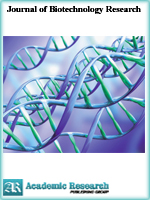Journal of Biotechnology Research
Online ISSN: 2413-3256
Print ISSN: 2413-8878
Print ISSN: 2413-8878
Quarterly Published (4 Issues Per Year)

Archives
Volume 5 Number 6 June 2019
Communal Use of Breeding Bulls on Bull Stations, Natural Mating and Artificial Insemination in Ethiopian Smallholder Dairy Farming Systems
Authors: Zemelak Goraga ; Asnaku Funga ; Tewodros Fekadu ; Seid Ali ; Gemeda Tuntuna ; Zenebe Tesfa ; Eyob G. Egziyabher ; Ejigayehu Demisse
Pages: 50-56
DOI: doi.org/10.32861/jbr.56.50.56
Abstract
The study was carried out to characterize Ethiopian smallholder farmers’ practice and indigenous knowledge on bull station service and adoption of different mating systems. A total of 62 respondents were selected from the smallholder dairy farming communities representing three districts in the Oromia region. A multistage sampling procedure was used to select sampling areas and respondents. A standardized questionnaire was used to collect qualitative and quantitative data using person to person interview. Data were analyzed using descriptive statistical procedures of SPSS. According to the findings of the study, Ethiopian smallholder dairy farmers are using both bull service and artificial insemination for dairy cattle breeding. The bulls used for mating are either those bulls kept for communal use at bull stations or bulls belong to individual farmers. The sources of all those bulls were research centers (15.5%), NGOs (37.5%), cooperatives (7.8%), born and grown at farmers’ own farms (10%) and other sources (29.2%). About 79% of the interviewed respondents were participants of bull station service and above 63% of them started to participate in less than a decade ago. In bull station, one bull did serve 3 to 30 females per week. In addition to the bull service, considerable numbers of farmers were using artificial insemination. The study revealed that both natural mating and artificial insemination methods are acceptable as appropriate mating systems and have their own advantage and disadvantages. So, bull service can be further adopted as an option for improving dairy production and productivity at smallholder farmers’ level particularly in areas where there is limited access for an efficient AI service. The study provided valuable information that can support the importance of using bull station services and adopt different mating systems to improve dairy cattle production and productivity in smallholder dairy farming systems in Ethiopia.



